It was a long drive to Abel Tasman after our stressful day on the glacier, but we split the driving between us and finally pulled into our accommodations around 9pm. We did some rearranging of our packs to make sure all our gear was in waterproof bags and then hit the sack to catch up on sleep for the next busy day ahead of us.
Abel Tasman National Park is well known for its gorgeous golden sand beaches, which you can visit either on foot, by kayak, or by water taxi. When I’d initially started researching Abel Tasman, I’d intended for us to just chill out in some kind of beach lodge for 3 days, but there’s actually no roads in the park, so we decided to make a pretty forgiving (read, slow) itinerary to see the park by kayak. Kayaking has been our newest hobby in Vancouver, so we were excited to try it out in New Zealand.
You can kayak the park either on a guided tour or you can self-explore in rented kayaks. We’ve gotten pretty comfortable on the water and it’s a lot cheaper to rent, so we opted for the self-guided option. We rented from Abel Tasman Kayaks and they run a pretty smooth operation, starting with 2 hours of classroom/on water kayak training before letting you embark on your own. Then they loaded us into a water taxi with our kayak and shuttled us up to the end of the park so that we could spend the next 3 days kayaking back to base at our leisure.
We always rent single kayaks in BC and we weren’t too impressed when they forced us to rent a double kayak for “safety” reasons. I was pretty skeptical because everything I’ve learned about kayaking in Canada has reinforced that it’s a lot easier to rescue someone when you have two boats. But ATK insisted that because of the wind in the area, its safer in one kayak – after having now completed the trip, I’ve decided I agree with them. Our kayak was called the “Packhorse Express” and with good reason. It was a BIG kayak. A lot wider than I was used to and extremely heavy. We struggled to lift it with 2 people even when it was empty, but more on that later!
Our shuttle dropped us a Onetahuti Beach, which is a gorgeous golden sand beach that stretches in a long half moon around the coast. It was noon by the time we landed on the beach and got our kayak packed, so we just had our lunch right there before setting out. Like I said, we planned for easy paddling days, so we decided to kayak up the coast in the opposite direction for a little while to visit Shag Harbour (Cormorants are known as Shags in NZ and NL people!). We’d heard it was really nice during high tide because you can paddle back into this river/tidal lagoon, which was really neat. It was a bit of a slow paddle up because we had a bit of a headwind, but it just made for a quicker paddle back down after! We stopped at another beach to go for a swim and then visited the Tonga Arches before paddling around the headland to Mosquito Bay, our campsite for the night.
Despite its name, Mosquito bay didn’t have any mosquitoes. It was still close to high tide when we landed, which was good because the beach is very shallow and there is a huge difference between the length of the beach at either tide and we didn’t want to have to carry our kayak up to high tide. The Heaphy Track, which is another of NZ’s Great Walks, runs along the coastline through the park as well, so a lot of the beaches and campsites are shared with hikers. But we picked Mosquito Bay because the track doesn’t run by the beach and you can only access it by boat, so we figured it would be less crowded.
That was a good idea in theory, but it was also still summer holidays for the locals and we discovered that a popular activity is beaching your boat on the shore at high tide and then camping in it overnight. So there was a whole line of tiny sailboats that had sailed into the tidal lagoon and were now beached up on the shore. But it was a beautiful campsite and the water was really warm, so I had a great swim. After some really questionable weather on the Milford Track and Fox Glacier, Abel Tasman rewarded us with sunny, hot days!
The weka’s were a lot more rampant in the Abel Tasman though and were real pests around the campsites. Seth loved it of course, but they were constantly pecking around waiting for you to let down your guard so they could swipe your food. We actually misplaced one of our little ziploc garbage bags on the second night and all we can figure is that a weka climbed into our tent vestibule overnight and swiped it out of our bag (just a reusable shopping bag). We felt really bad about it and searched the woods all around the campsite to see if we could find any garbage, but there was no sign of it.
We had a lazy evening at Mosquito Beach and I convinced Seth to sleep with the fly off the tent so that we could watch the stars overnight. I don’t think Seth really did any stargazing, but I had a great time and I did see a ton of stars and the milky way. It was interesting sleeping conditions though, probably because it was so warm, and I woke up with a layer of dew right over my sleeping bag, which has never happened to me in BC mountains when I sleep with the fly off.
Day 2 was my favourite day of the trip. We had a lazy start, but unfortunately this time we did have to drag the kayaks all the way down the beach to put out at a much lower tide. High tide is really better in the Abel Tasman because you can access the tidal lagoons when the tide is up, so we had a lazy paddle to Bark Bay and Sandfly Beach and did a little exploring on the beaches since we couldn’t get into the lagoons.
We had a little setback when we tried to go to one of the islands to look for seals, it was just too windy out there and after a lot of splashing around we gave up and navigated back to the shore. We had lunch in Frenchman’s Bay and then kayaked over to Torrent Bay, which was one of my favourite beaches. Torrent Beach juts right out into the bay with a massive tidal lagoon behind it. I think the lagoon always has some water in it, but how far back into the lagoon you can go is dictated by how high the tide is. 2 hours before and after high tide is the best time, so we decided to go for a swim on the lagoon side of Torrent Beach to kill some time. The water was so warm and as someone who loves swimming, I was so content swimming around in the bay.
2 hours before high tide we started to make our way in to the bay and landed our kayaks at the end. ATK had recommended checking out part of the Heaphy Track and hiking up to a little swimming hole called Cleopatra’s Pool. Unfortunately, we got the wrong landing point for the trail, so our walk was a few kms longer then it had to be, but it was neat to explore another one of the great walks. Between backpackers and hikers, there were a lot of people on the beach. There’s a big hut at nearby Anchorage Beach, so I think the trail draws a lot of day traffic from there. The pool was pretty nice – colder than the ocean, but not as cold as the glacial rivers. There were several little waterfalls, so we explored around a bit before heading back to our kayaks.
It was around 4pm when we finished, so we decided it was time to make our way to our next campsite at Te Pukatea Bay while we still had the high tide working for us. Te Pukatea Bay is located just on the other side of the headland, separating it from Anchorage. It’s only about a 10-15 minute walk between them, but a bit more of a challenging paddle going around the headland. We had a headwind and it was windy, but still manageable. I was happy when we finally pulled up to the beach though.
Te Pukatea Bay ended up being my favourite beach! There were no boats or yachts along the beach and surprisingly few people camping there. It seems the facilities at Anchorage draw most of the crowds. We went for our third and final swim of the day and then took it easy and enjoyed the views. We went on a short walk around sunset and found a lookout gazing out towards anchorage and were rewarded with the most gorgeous pink sunset! Then on our way back to the campsite, we finally found the elusive morepork, a little owl that Seth had been trying to see since the start of the trip. They have a distinctive call and we’d heard them several times, but one almost dived bombed Seth’s head and we finally got a good look at it sitting in the tree at dusk – it was very cute!
Our last day was a bit of a challenge. Keeping with the theme of the rest of the trip, Abel Tasman was experiencing “abnormal summer weather”. The first section after Te Pukatea Beach is known as the “Mad Mile”, so we knew it was going to be a rough paddle, but figured at least our arms would be fresh after a day of rest.
It was really windy and by far the hardest part of the trip. At first it seemed manageable and we were feeling pretty good about ourselves, but the further we went around the headland, the less it seemed we were moving forward. We had a headwind coming at us from the front, but there was also a swell on – so we had to keep away from the shelter of the land because the swell kept crashing against the rocks. So we had the wind against us in front and a side swell to battle at the same time. I think I may be prone to anxiety because I had a bit of a freak-out in the middle of the paddle because I felt we were going nowhere and the waves made me really nervous. But Seth was super calm; he knew we were making progress and that we just had to push through.
That one mile is why I changed my mind about the double kayak. Single kayaks seems to be the way to go in BC, but our Packhorse Express was definitely made for big waves and at no point during the paddle did I feel at any risk of tipping the boat. I’ll also appreciated being in the same boat as Seth in that moment because he is a stronger paddler than me and I think we would have become separated if we’d been in two boats, which would definitely have stressed me out a lot more.
But we finally made it to the next beach and hauled the kayak up on shore for a well deserved break. It was still windy, but the paddling was easier so we had a nice time exploring a few more beaches on the way back. We decided to aim for Appletree Beach for lunch, which is the last stopping point before you head back to the rental. The map told us that they run water taxis from Appletree Beach because sometimes the wind gets too strong going back and to wait there if you didn’t think you could make it around the headland.
I think we could have gone all the way back, but the weather got noticeably windier the closer we got to Appletree Beach and we had a hard time landing the kayak on the beach. I decided it was time to call it quits and figured we could just wait for a water taxi while we ate our lunch. We got super lucky though and ATK went by in their boat just after we landed on the beach (we were still bailing the water out of the kayak from our awkward landing). I flagged them down right away and he didn’t hesitate in loading our boat on board and bringing us straight to the end. He said it was not good conditions at all and I think he was pretty much just running around retrieving people.
We only skipped about an hour of paddling, but I definitely think it was worth it. We were thrilled to have a hot shower back at the base camp and eat our lunch there. It was a challenging last day, but overall I had so much fun kayaking around the Abel Tasman. It was hot, sunny, and had amazing views, which is really all you can ask for!
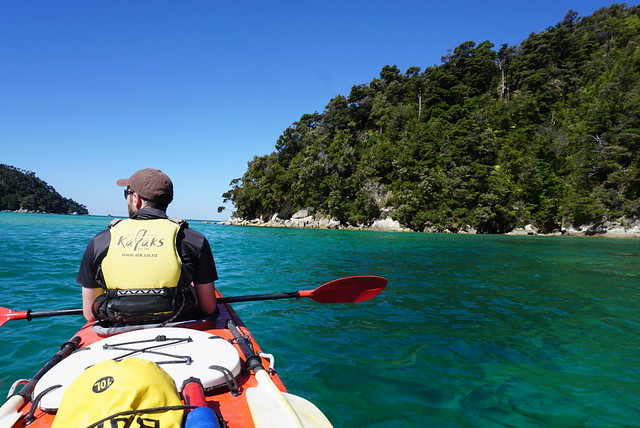
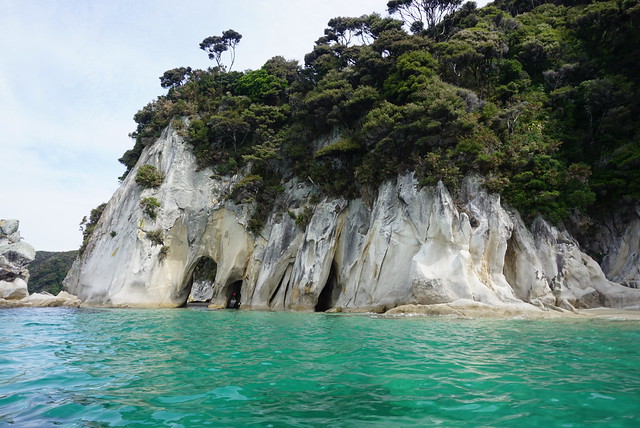
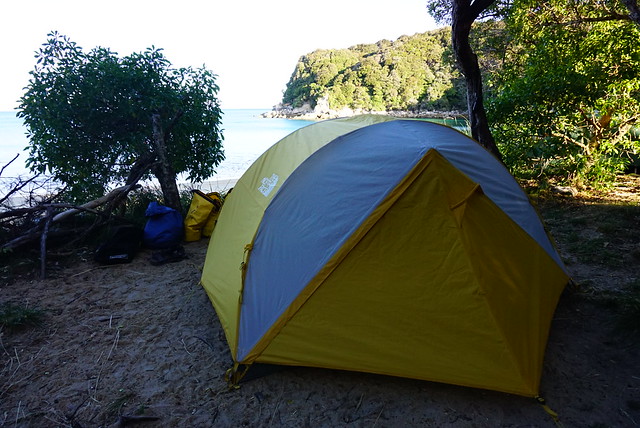
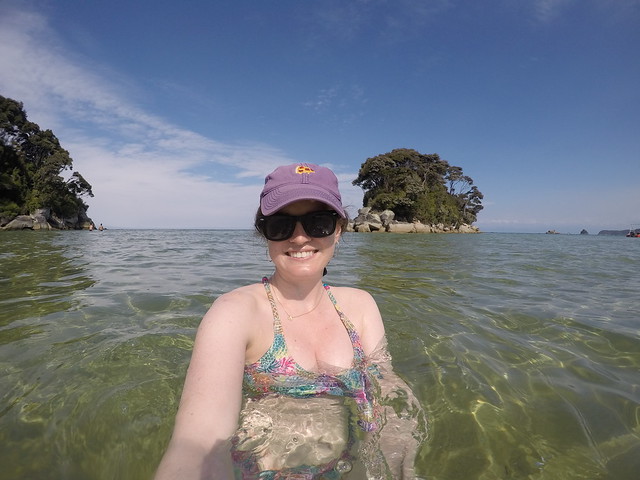
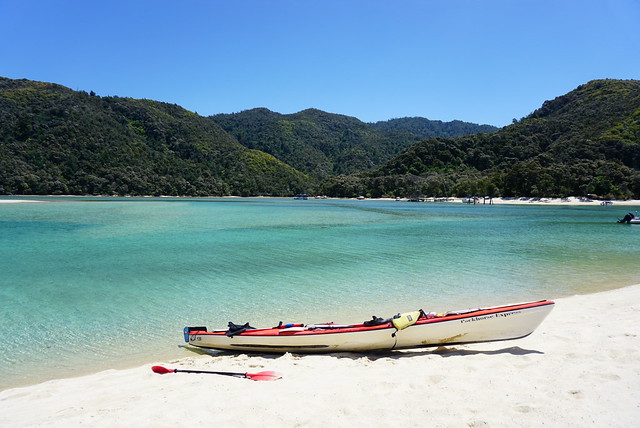
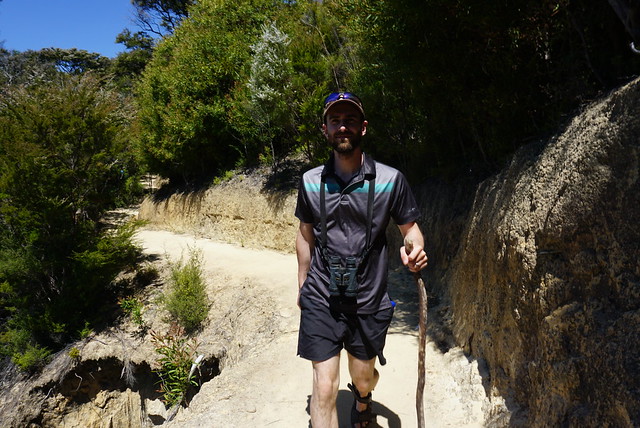
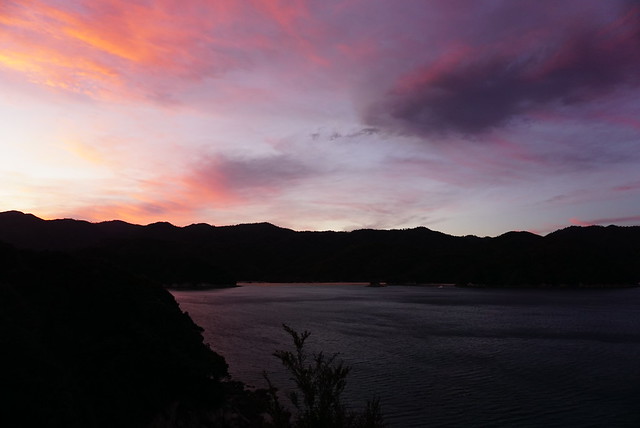
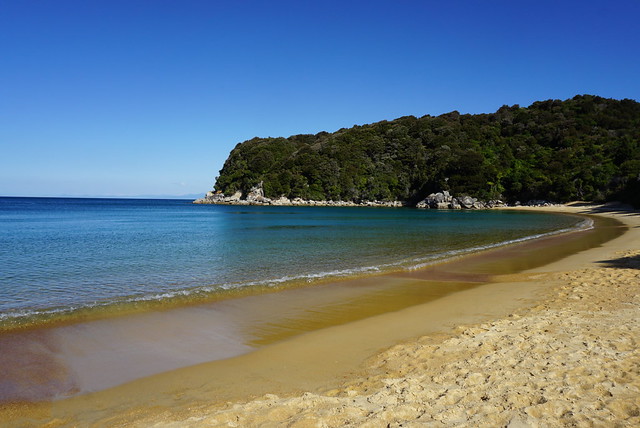
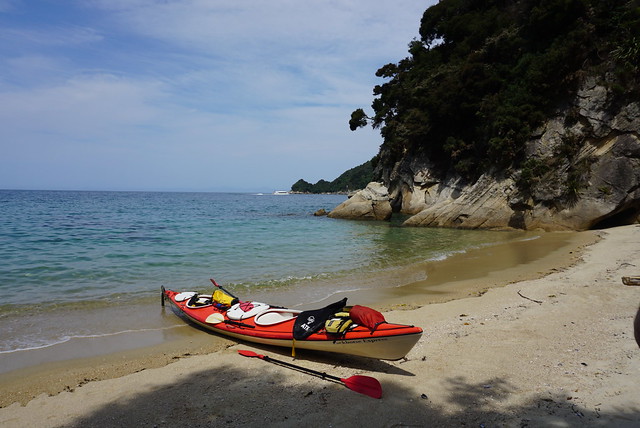
Pingback: Kayaking Sooke Basin | The Road Goes Ever On